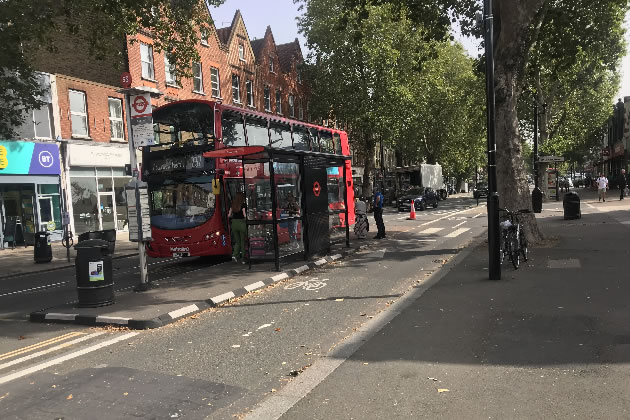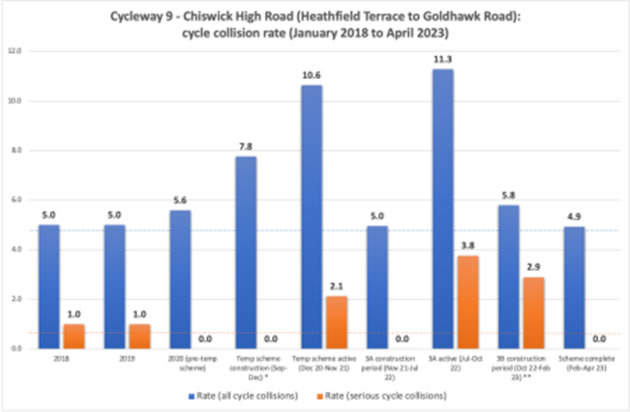Opposition Call-in Decision to Make Cycleway 9 Permanent
Says evidence to support the decision was flawed

Councillors dispute evidence that Cycleway has made High Road safer for cyclists
September 17, 2023
Conservative opposition councillors in Hounslow have called-in the cabinet’s recent decision to make C9 permanent.
They are arguing that the evidence used to justify the decision on the £13million project was flawed and have presented their own detailed analysis questioning details of the Monitoring Report provided by Transport for London claims made in the cabinet papers submitted at the meeting at which the move was approved.
The grounds for the objections include inaccuracies in the use of statistics on collisions, the use of data to show the level of increase in cycling, the impact on journey times and equalities issues, particularly with regard to the disabled.
The council’s decision to make the scheme permanent does not refer to the physical infrastructure but that it would be in future enable by a permanent traffic order rather than an experimental one which means that it would no longer be subject to further review.
‘Calling-in’ the decision means that the concerns raised will now be considered by a panel of the council’s overview and scrutiny committee on 21 September. This body has a Labour majority but is made up of councillors from both parties who are not members of the cabinet.
Cllr Peter Thompson (Chiswick Riverside ward) said, “It seemed clear to us that the data provided to support the decision to make C9 permanent had been ignored and the scheme had been deemed a success based on a very narrow view. Even the cabinet report states that the decision is open to challenge. We would not be fulfilling our role as the opposition group – to hold the council to account – if we failed to challenge this misinterpretation of the data and the fact that crucial data is missing. We found that the call-in is justified on three of the six possible reasons for a call-in:
• the absence of adequate evidence on which to base a decision
• the action is not proportionate to the desired outcome
• a potential human rights challenge.
"A call-in doesn't have the power to stop or postpone a scheme such as Cycleway 9 but given the amount of controversy and division in the community about this scheme we need to be sure that the decision made by the Cabinet was based on sound evidence."
The Conservative call-in includes data which challenges the data provided by the council including on collisions which are only slightly lower than before C9 was built with two months of data still to be provided, and with 'serious cycle collisions nearly four times higher after the first phase opened'.
The TfL Monitoring Report had argued that Cycleway 9 was demonstrating that it was making cyclists safer as there had been no recorded serious injuries since the new junction treatments were put in place earlier this year. However, a report submitted with the call-in queries how much time there has been to measure collision accurately for the period from February to June 2023 when the second phase was complete. It is argued that, because of the time lag in TfL updating its collision data, the numbers for much of this period could remain provisional.
The report with the call-in submission states, “TfL should clarify whether the collision data they have cited from "Feb-June 2023” is in fact verified data, or only provisional. If the later, then it should have been labelled as such in the cabinet report, along with a ‘health warning’ that the number and severity of collisions may increase once the verification process is complete.”
It goes on to say that TfL data shows that cycle collisions doubled during both previous periods when C9 was fully open that and 2021 would subsequently prove to be the worst year in TfL’s road safety records for cycle collisions along the C9 route on Chiswick High Road despite earlier unverified data suggesting collisions had reduced.
It is also pointed out that, although the fully upgraded cycleway reopened on 16 February this year, sections of it were completed beforehand and a collision on Brackley Road happened when a side road entry treatment had been completed which undermined the claim that the new layouts had made the area safer for cyclists.
The chart below suggests that the collision rate (to date) since the full re-opening of C9 is only slightly lower than those in 2018 and 2019 before C9 was built. If any further collisions come to light once the data for May & June is verified, then the collision rate in 2023 could yet become worse.

The call-in is also justified by a challenge to the methodology used to claim a 47% increase in cycling on Chiswick High Road which it is said is “a new metric, which potentially relies on inaccurate data & flawed methodology” and it is question why no 2023 cycle counts were provided in the TfL report even though it would have access to the data.
“Cycle kms” are a calculation to estimate cycle demand along the entire route and depend on data from the digital cameras at the junction with Heathfield Terrace and Turnham Green Terrace. TfL admitted at an earlier stage that collection of data from this source was ‘challenging’, therefore it is argued that it is not a sound basis for assessing the increase in cyclist use and the lower figure from more traditional cycle counts should be used with the report stating, “400 extra cyclists do not represent a good return on £13m of investment”.
The call-in papers also suggest that the effects of higher journey times for buses and other vehicles on the High Road since the cycleway was installed were downplayed by describing it as an extra 1minute per kilometre which actually represents a 50% rise for a vehicle travelling at 20mph.
Claims in the cabinet paper that the main pollutants in the area have faller or are below EU limits are dismissed as they are in line with similar locations and because the reduction in the number of vehicles on the High Road should have resulted in larger improvements. Moreover levels of harmful PM2.5 particulates increased in 2022 to a level of 12 mg/m3 – in excess of the target of 10 mg/m3 set by the UK government and the Mayor of London.
The opposition also says that, as the council’s equalities assessment notes that impact on "some equality groups or individuals" is likely further complaints about the scheme will arise and litigation is a possibility.
“We are particularly concerned that the cabinet member dismisses these concerns saying that there are ‘different interpretations of data’. When lives and livelihoods are at risk, it is crucial to interpret data factually not figuratively, and not to look for different measurements because like-for-like comparisons do not meet the council’s hoped-for outcomes”, Cllr Thompson concluded.
Should the scrutiny committee concur with the concerns raised by the call-in, it is able to refer the decision back to cabinet. This would not oblige the council to take any action other than to acknowledge the report and confirm that it has reviewed its original decision and sticks by it.
Like Reading Articles Like This? Help Us Produce More This site remains committed to providing local community news and public interest journalism. Articles such as the one above are integral to what we do. We aim to feature as much as possible on local societies, charities based in the area, fundraising efforts by residents, community-based initiatives and even helping people find missing pets. We've always done that and won't be changing, in fact we'd like to do more. However, the readership that these stories generates is often below that needed to cover the cost of producing them. Our financial resources are limited and the local media environment is intensely competitive so there is a constraint on what we can do. We are therefore asking our readers to consider offering financial support to these efforts. Any money given will help support community and public interest news and the expansion of our coverage in this area. A suggested monthly payment is £8 but we would be grateful for any amount for instance if you think this site offers the equivalent value of a subscription to a daily printed newspaper you may wish to consider £20 per month. If neither of these amounts is suitable for you then contact info@neighbournet.com and we can set up an alternative. All payments are made through a secure web site. One-off donations are also appreciated. Choose The Amount You Wish To Contribute. If you do support us in this way we'd be interested to hear what kind of articles you would like to see more of on the site – send your suggestions to the editor. For businesses we offer the chance to be a corporate sponsor of community content on the site. For £30 plus VAT per month you will be the designated sponsor of at least one article a month with your logo appearing if supplied. If there is a specific community group or initiative you'd like to support we can make sure your sponsorship is featured on related content for a one off payment of £50 plus VAT. All payments are made through a secure web site. |